Snowflake Developer Resume Examples
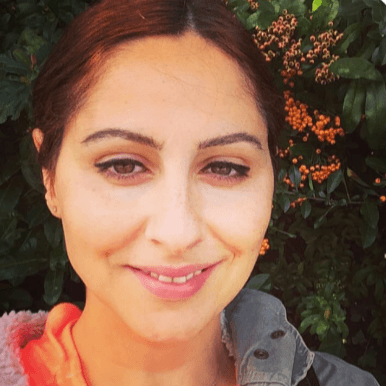
Aug 27, 2024
|
12 min read
Learn how to write a standout snowflake developer resume that turns hiring managers from frosty to friendly. This guide will help you highlight your unique skills and make your resume a flurry of success.
Rated by 348 people
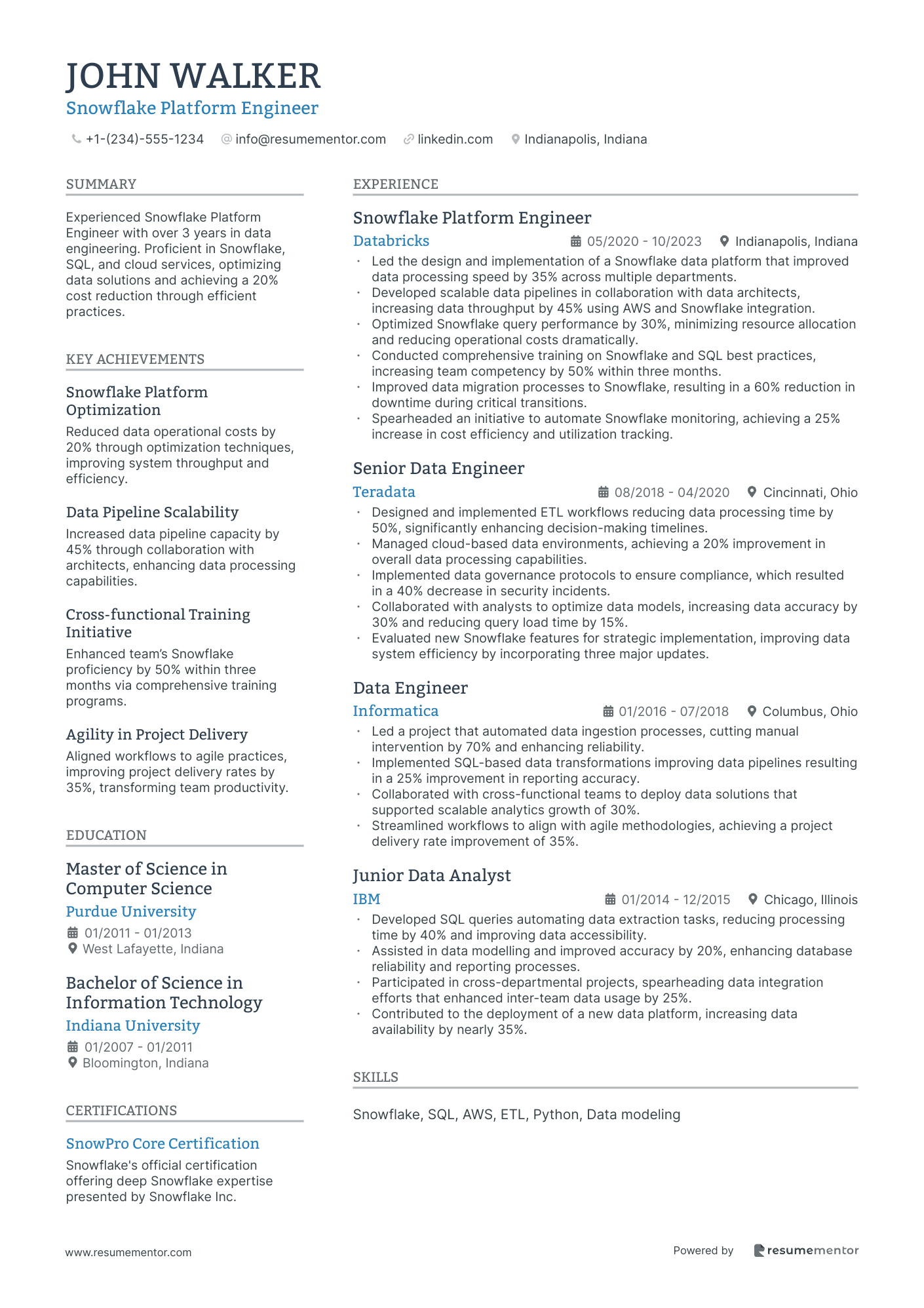
Snowflake Platform Engineer
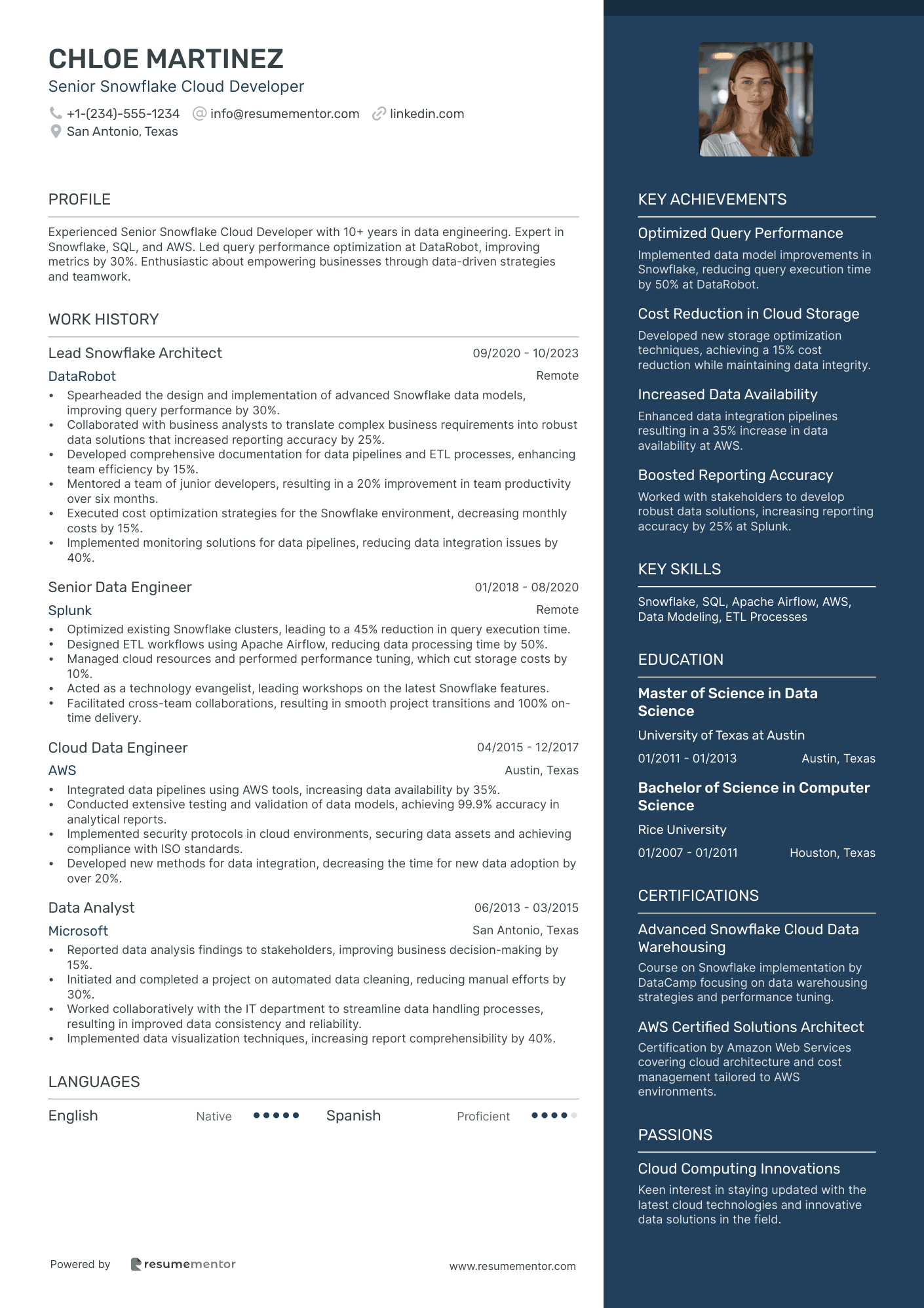
Senior Snowflake Cloud Developer
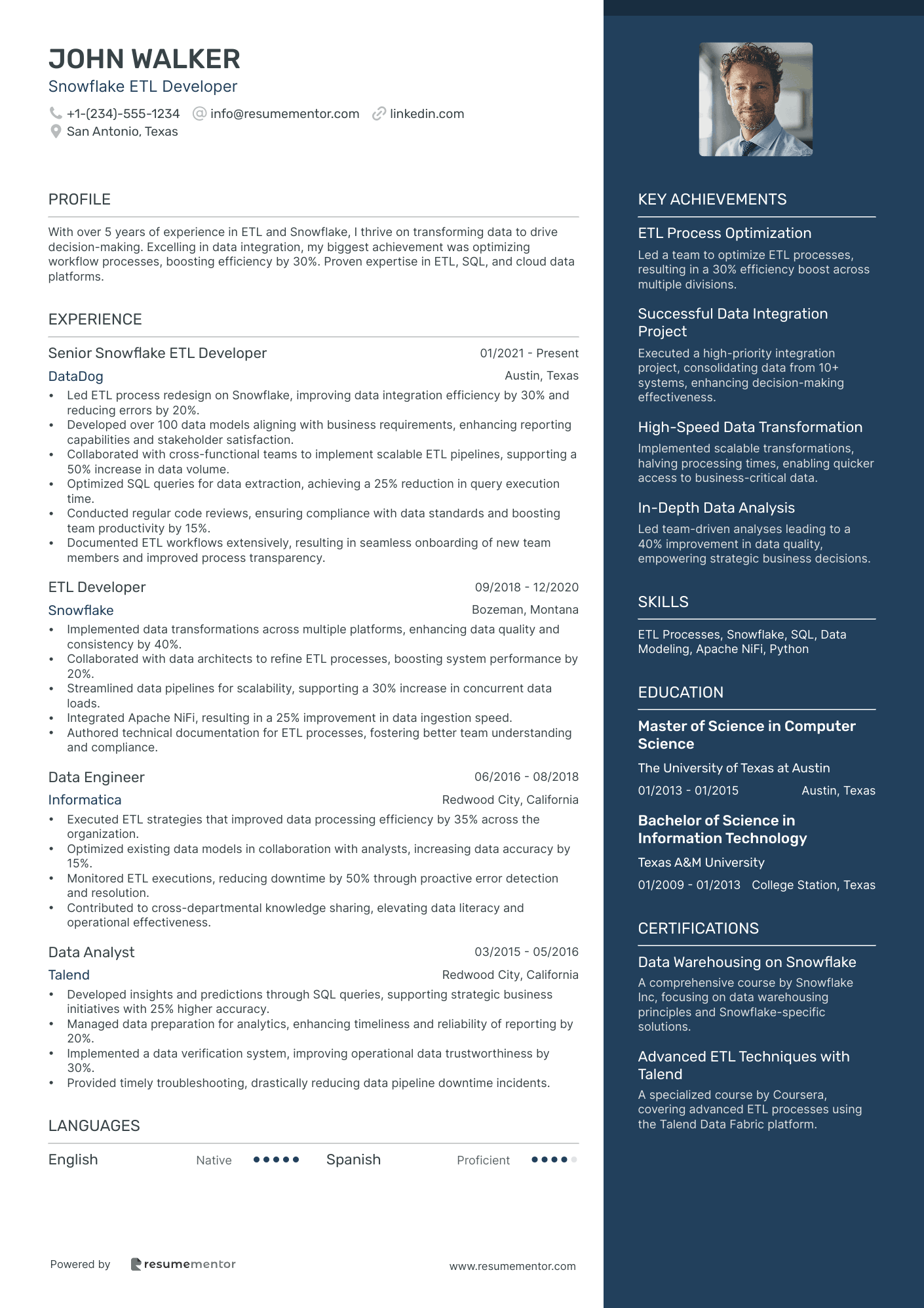
Snowflake ETL Developer
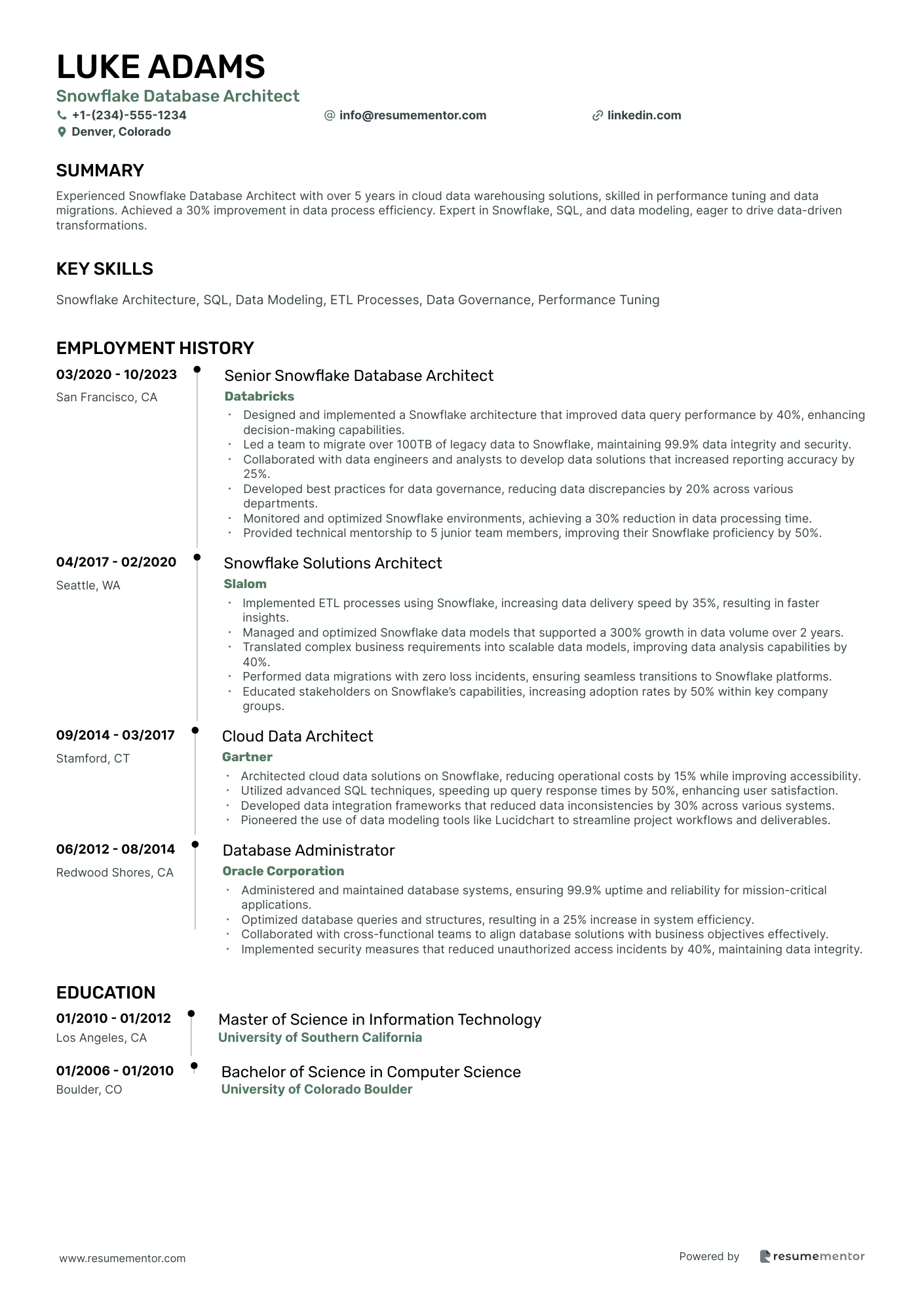
Snowflake Database Architect
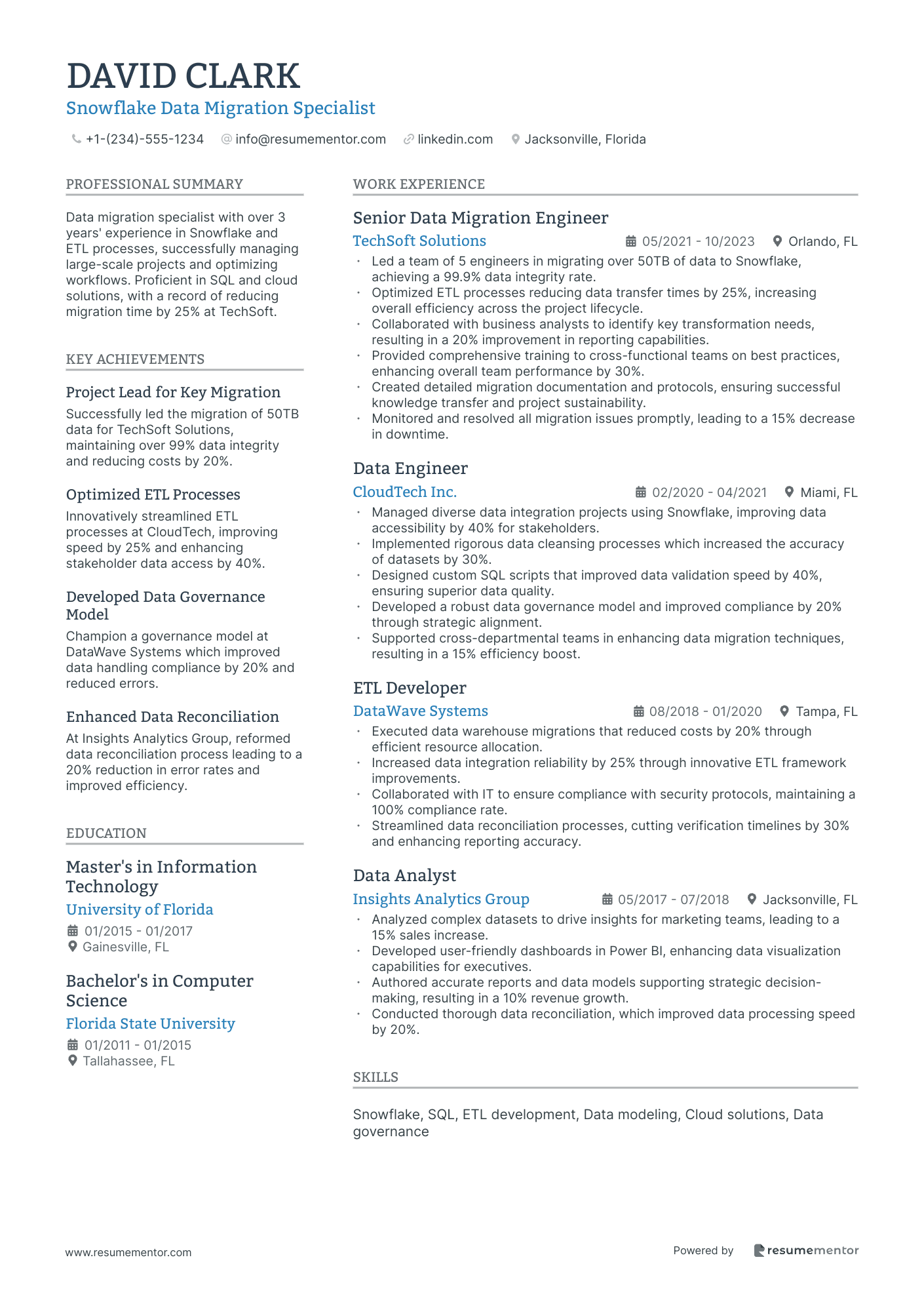
Snowflake Data Migration Specialist
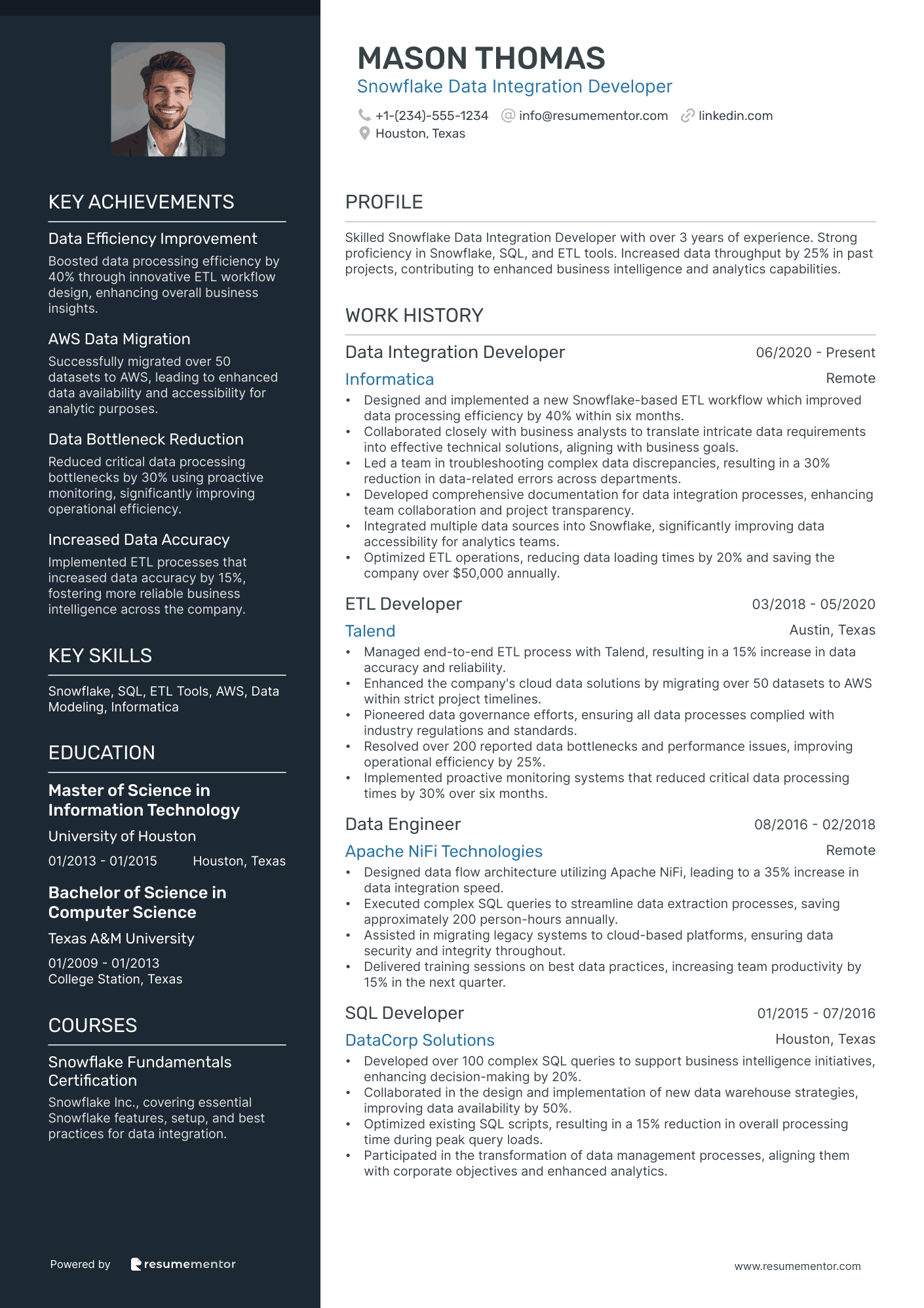
Snowflake Data Integration Developer
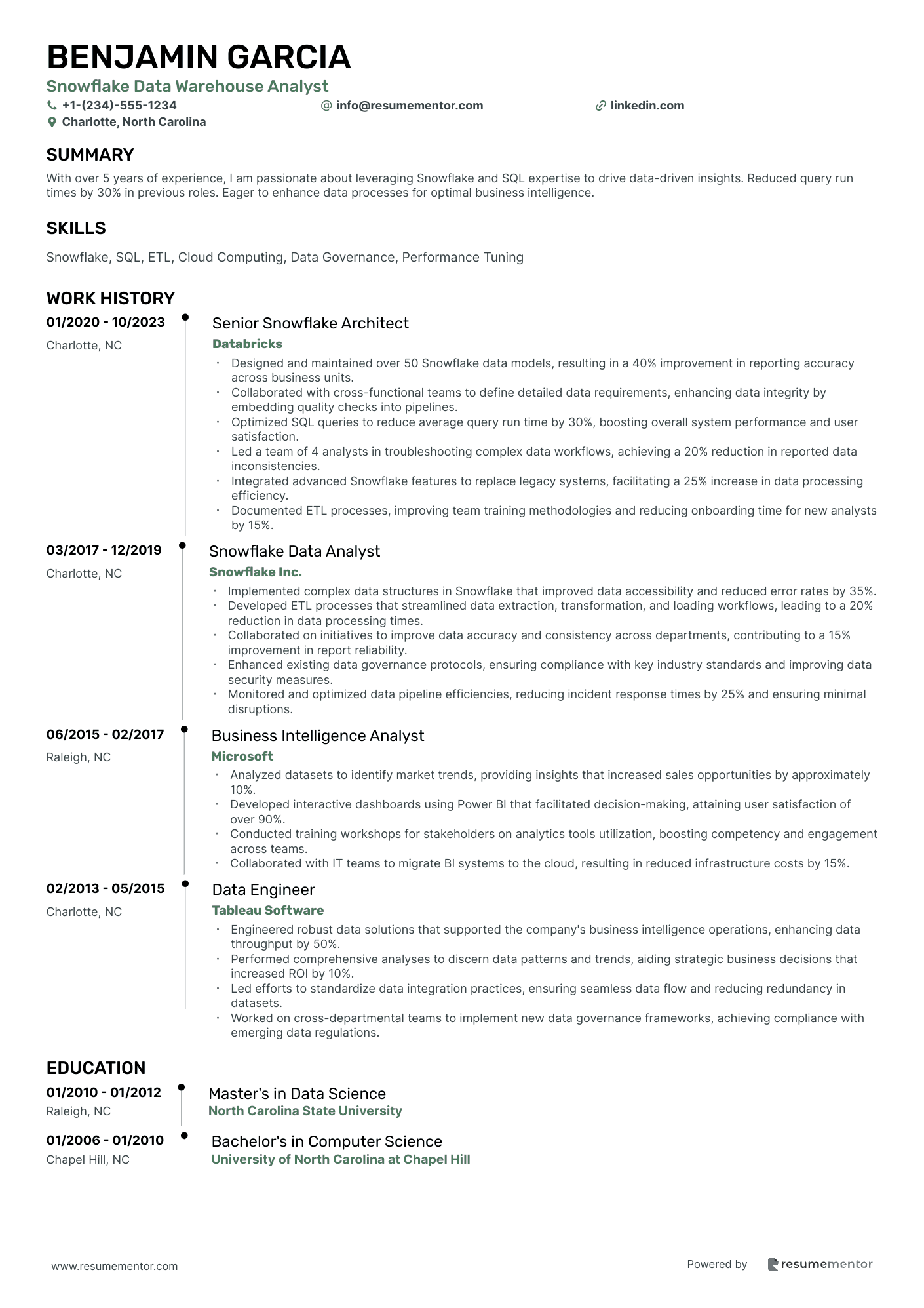
Snowflake Data Warehouse Analyst
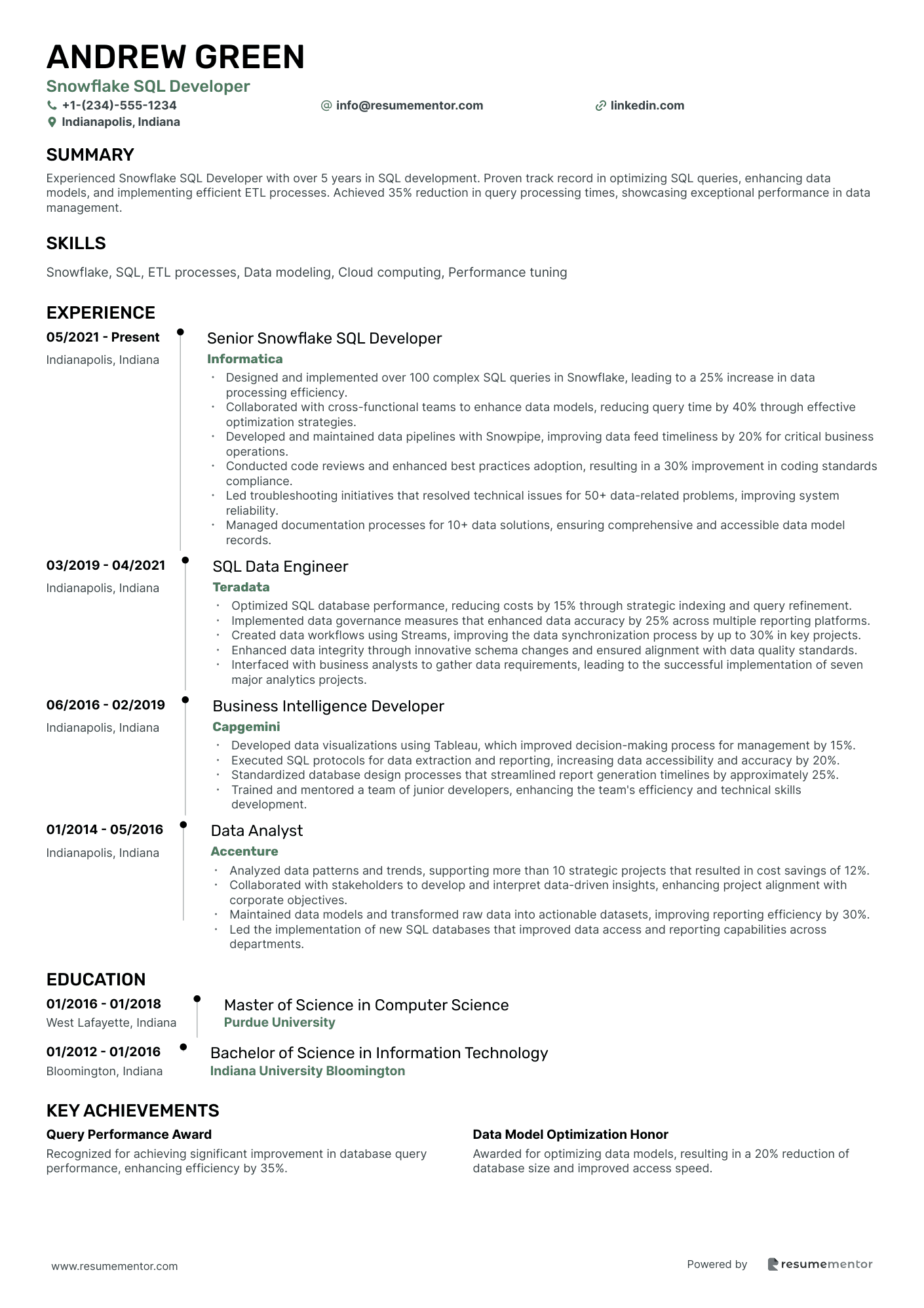
Snowflake SQL Developer
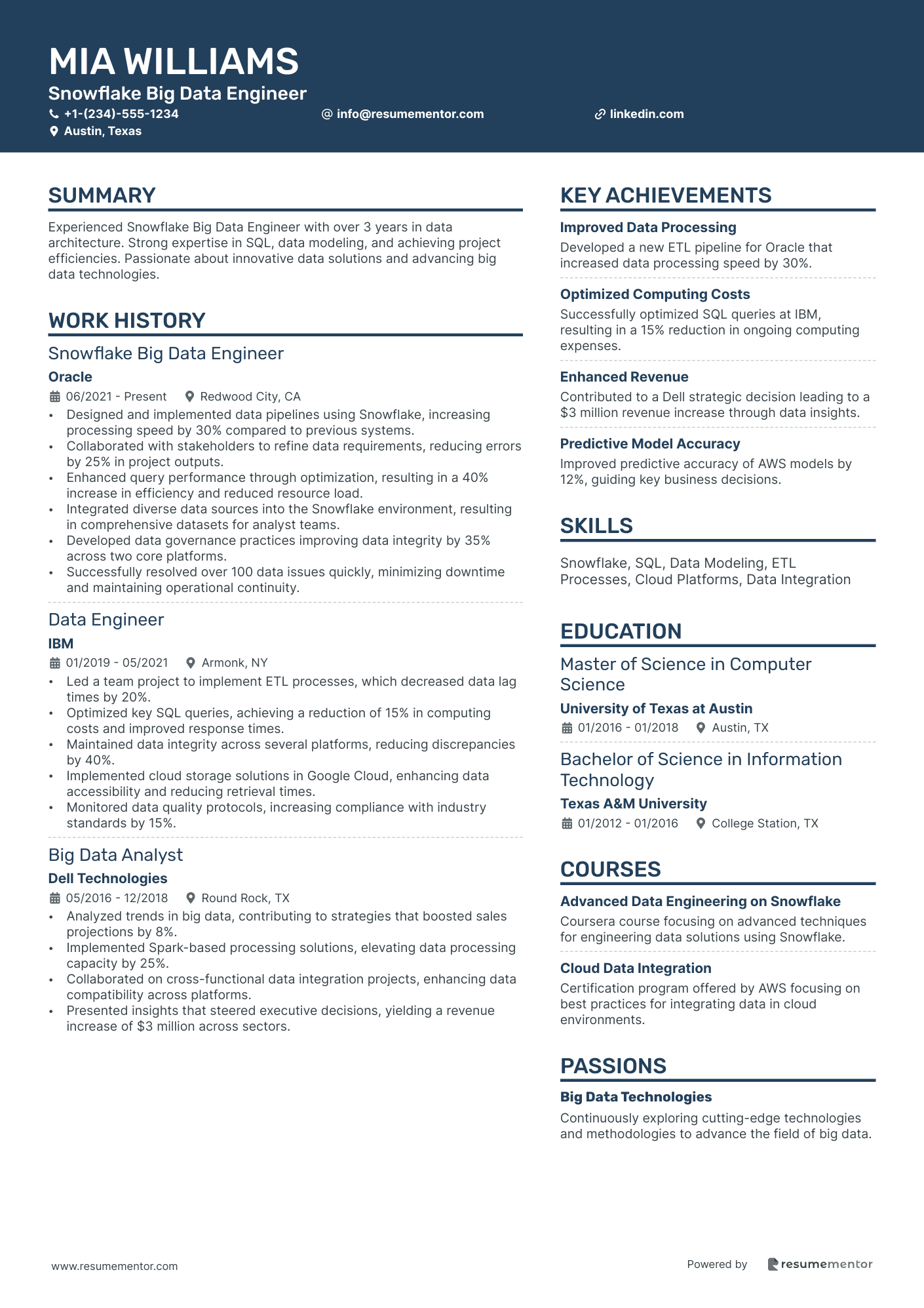
Snowflake Big Data Engineer
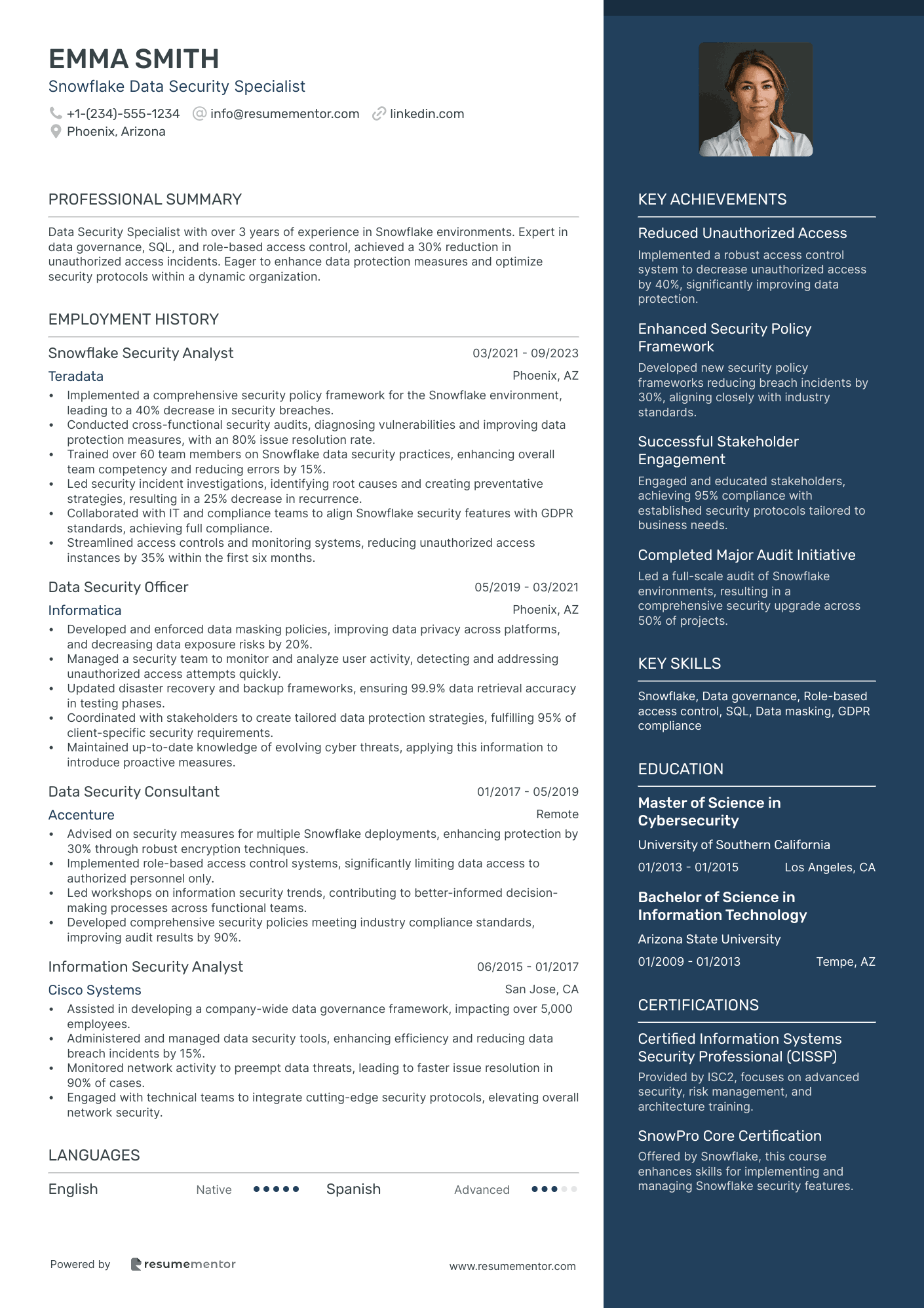
Snowflake Data Security Specialist

Snowflake Platform Engineer resume sample
- •Led the design and implementation of a Snowflake data platform that improved data processing speed by 35% across multiple departments.
- •Developed scalable data pipelines in collaboration with data architects, increasing data throughput by 45% using AWS and Snowflake integration.
- •Optimized Snowflake query performance by 30%, minimizing resource allocation and reducing operational costs dramatically.
- •Conducted comprehensive training on Snowflake and SQL best practices, increasing team competency by 50% within three months.
- •Improved data migration processes to Snowflake, resulting in a 60% reduction in downtime during critical transitions.
- •Spearheaded an initiative to automate Snowflake monitoring, achieving a 25% increase in cost efficiency and utilization tracking.
- •Designed and implemented ETL workflows reducing data processing time by 50%, significantly enhancing decision-making timelines.
- •Managed cloud-based data environments, achieving a 20% improvement in overall data processing capabilities.
- •Implemented data governance protocols to ensure compliance, which resulted in a 40% decrease in security incidents.
- •Collaborated with analysts to optimize data models, increasing data accuracy by 30% and reducing query load time by 15%.
- •Evaluated new Snowflake features for strategic implementation, improving data system efficiency by incorporating three major updates.
- •Led a project that automated data ingestion processes, cutting manual intervention by 70% and enhancing reliability.
- •Implemented SQL-based data transformations improving data pipelines resulting in a 25% improvement in reporting accuracy.
- •Collaborated with cross-functional teams to deploy data solutions that supported scalable analytics growth of 30%.
- •Streamlined workflows to align with agile methodologies, achieving a project delivery rate improvement of 35%.
- •Developed SQL queries automating data extraction tasks, reducing processing time by 40% and improving data accessibility.
- •Assisted in data modelling and improved accuracy by 20%, enhancing database reliability and reporting processes.
- •Participated in cross-departmental projects, spearheading data integration efforts that enhanced inter-team data usage by 25%.
- •Contributed to the deployment of a new data platform, increasing data availability by nearly 35%.
Senior Snowflake Cloud Developer resume sample
- •Spearheaded the design and implementation of advanced Snowflake data models, improving query performance by 30%.
- •Collaborated with business analysts to translate complex business requirements into robust data solutions that increased reporting accuracy by 25%.
- •Developed comprehensive documentation for data pipelines and ETL processes, enhancing team efficiency by 15%.
- •Mentored a team of junior developers, resulting in a 20% improvement in team productivity over six months.
- •Executed cost optimization strategies for the Snowflake environment, decreasing monthly costs by 15%.
- •Implemented monitoring solutions for data pipelines, reducing data integration issues by 40%.
- •Optimized existing Snowflake clusters, leading to a 45% reduction in query execution time.
- •Designed ETL workflows using Apache Airflow, reducing data processing time by 50%.
- •Managed cloud resources and performed performance tuning, which cut storage costs by 10%.
- •Acted as a technology evangelist, leading workshops on the latest Snowflake features.
- •Facilitated cross-team collaborations, resulting in smooth project transitions and 100% on-time delivery.
- •Integrated data pipelines using AWS tools, increasing data availability by 35%.
- •Conducted extensive testing and validation of data models, achieving 99.9% accuracy in analytical reports.
- •Implemented security protocols in cloud environments, securing data assets and achieving compliance with ISO standards.
- •Developed new methods for data integration, decreasing the time for new data adoption by over 20%.
- •Reported data analysis findings to stakeholders, improving business decision-making by 15%.
- •Initiated and completed a project on automated data cleaning, reducing manual efforts by 30%.
- •Worked collaboratively with the IT department to streamline data handling processes, resulting in improved data consistency and reliability.
- •Implemented data visualization techniques, increasing report comprehensibility by 40%.
Snowflake ETL Developer resume sample
- •Led ETL process redesign on Snowflake, improving data integration efficiency by 30% and reducing errors by 20%.
- •Developed over 100 data models aligning with business requirements, enhancing reporting capabilities and stakeholder satisfaction.
- •Collaborated with cross-functional teams to implement scalable ETL pipelines, supporting a 50% increase in data volume.
- •Optimized SQL queries for data extraction, achieving a 25% reduction in query execution time.
- •Conducted regular code reviews, ensuring compliance with data standards and boosting team productivity by 15%.
- •Documented ETL workflows extensively, resulting in seamless onboarding of new team members and improved process transparency.
- •Implemented data transformations across multiple platforms, enhancing data quality and consistency by 40%.
- •Collaborated with data architects to refine ETL processes, boosting system performance by 20%.
- •Streamlined data pipelines for scalability, supporting a 30% increase in concurrent data loads.
- •Integrated Apache NiFi, resulting in a 25% improvement in data ingestion speed.
- •Authored technical documentation for ETL processes, fostering better team understanding and compliance.
- •Executed ETL strategies that improved data processing efficiency by 35% across the organization.
- •Optimized existing data models in collaboration with analysts, increasing data accuracy by 15%.
- •Monitored ETL executions, reducing downtime by 50% through proactive error detection and resolution.
- •Contributed to cross-departmental knowledge sharing, elevating data literacy and operational effectiveness.
- •Developed insights and predictions through SQL queries, supporting strategic business initiatives with 25% higher accuracy.
- •Managed data preparation for analytics, enhancing timeliness and reliability of reporting by 20%.
- •Implemented a data verification system, improving operational data trustworthiness by 30%.
- •Provided timely troubleshooting, drastically reducing data pipeline downtime incidents.
Snowflake Database Architect resume sample
- •Designed and implemented a Snowflake architecture that improved data query performance by 40%, enhancing decision-making capabilities.
- •Led a team to migrate over 100TB of legacy data to Snowflake, maintaining 99.9% data integrity and security.
- •Collaborated with data engineers and analysts to develop data solutions that increased reporting accuracy by 25%.
- •Developed best practices for data governance, reducing data discrepancies by 20% across various departments.
- •Monitored and optimized Snowflake environments, achieving a 30% reduction in data processing time.
- •Provided technical mentorship to 5 junior team members, improving their Snowflake proficiency by 50%.
- •Implemented ETL processes using Snowflake, increasing data delivery speed by 35%, resulting in faster insights.
- •Managed and optimized Snowflake data models that supported a 300% growth in data volume over 2 years.
- •Translated complex business requirements into scalable data models, improving data analysis capabilities by 40%.
- •Performed data migrations with zero loss incidents, ensuring seamless transitions to Snowflake platforms.
- •Educated stakeholders on Snowflake’s capabilities, increasing adoption rates by 50% within key company groups.
- •Architected cloud data solutions on Snowflake, reducing operational costs by 15% while improving accessibility.
- •Utilized advanced SQL techniques, speeding up query response times by 50%, enhancing user satisfaction.
- •Developed data integration frameworks that reduced data inconsistencies by 30% across various systems.
- •Pioneered the use of data modeling tools like Lucidchart to streamline project workflows and deliverables.
- •Administered and maintained database systems, ensuring 99.9% uptime and reliability for mission-critical applications.
- •Optimized database queries and structures, resulting in a 25% increase in system efficiency.
- •Collaborated with cross-functional teams to align database solutions with business objectives effectively.
- •Implemented security measures that reduced unauthorized access incidents by 40%, maintaining data integrity.
Snowflake Data Migration Specialist resume sample
- •Led a team of 5 engineers in migrating over 50TB of data to Snowflake, achieving a 99.9% data integrity rate.
- •Optimized ETL processes reducing data transfer times by 25%, increasing overall efficiency across the project lifecycle.
- •Collaborated with business analysts to identify key transformation needs, resulting in a 20% improvement in reporting capabilities.
- •Provided comprehensive training to cross-functional teams on best practices, enhancing overall team performance by 30%.
- •Created detailed migration documentation and protocols, ensuring successful knowledge transfer and project sustainability.
- •Monitored and resolved all migration issues promptly, leading to a 15% decrease in downtime.
- •Managed diverse data integration projects using Snowflake, improving data accessibility by 40% for stakeholders.
- •Implemented rigorous data cleansing processes which increased the accuracy of datasets by 30%.
- •Designed custom SQL scripts that improved data validation speed by 40%, ensuring superior data quality.
- •Developed a robust data governance model and improved compliance by 20% through strategic alignment.
- •Supported cross-departmental teams in enhancing data migration techniques, resulting in a 15% efficiency boost.
- •Executed data warehouse migrations that reduced costs by 20% through efficient resource allocation.
- •Increased data integration reliability by 25% through innovative ETL framework improvements.
- •Collaborated with IT to ensure compliance with security protocols, maintaining a 100% compliance rate.
- •Streamlined data reconciliation processes, cutting verification timelines by 30% and enhancing reporting accuracy.
- •Analyzed complex datasets to drive insights for marketing teams, leading to a 15% sales increase.
- •Developed user-friendly dashboards in Power BI, enhancing data visualization capabilities for executives.
- •Authored accurate reports and data models supporting strategic decision-making, resulting in a 10% revenue growth.
- •Conducted thorough data reconciliation, which improved data processing speed by 20%.
Snowflake Data Integration Developer resume sample
- •Designed and implemented a new Snowflake-based ETL workflow which improved data processing efficiency by 40% within six months.
- •Collaborated closely with business analysts to translate intricate data requirements into effective technical solutions, aligning with business goals.
- •Led a team in troubleshooting complex data discrepancies, resulting in a 30% reduction in data-related errors across departments.
- •Developed comprehensive documentation for data integration processes, enhancing team collaboration and project transparency.
- •Integrated multiple data sources into Snowflake, significantly improving data accessibility for analytics teams.
- •Optimized ETL operations, reducing data loading times by 20% and saving the company over $50,000 annually.
- •Managed end-to-end ETL process with Talend, resulting in a 15% increase in data accuracy and reliability.
- •Enhanced the company's cloud data solutions by migrating over 50 datasets to AWS within strict project timelines.
- •Pioneered data governance efforts, ensuring all data processes complied with industry regulations and standards.
- •Resolved over 200 reported data bottlenecks and performance issues, improving operational efficiency by 25%.
- •Implemented proactive monitoring systems that reduced critical data processing times by 30% over six months.
- •Designed data flow architecture utilizing Apache NiFi, leading to a 35% increase in data integration speed.
- •Executed complex SQL queries to streamline data extraction processes, saving approximately 200 person-hours annually.
- •Assisted in migrating legacy systems to cloud-based platforms, ensuring data security and integrity throughout.
- •Delivered training sessions on best data practices, increasing team productivity by 15% in the next quarter.
- •Developed over 100 complex SQL queries to support business intelligence initiatives, enhancing decision-making by 20%.
- •Collaborated in the design and implementation of new data warehouse strategies, improving data availability by 50%.
- •Optimized existing SQL scripts, resulting in a 15% reduction in overall processing time during peak query loads.
- •Participated in the transformation of data management processes, aligning them with corporate objectives and enhanced analytics.
Snowflake Data Warehouse Analyst resume sample
- •Designed and maintained over 50 Snowflake data models, resulting in a 40% improvement in reporting accuracy across business units.
- •Collaborated with cross-functional teams to define detailed data requirements, enhancing data integrity by embedding quality checks into pipelines.
- •Optimized SQL queries to reduce average query run time by 30%, boosting overall system performance and user satisfaction.
- •Led a team of 4 analysts in troubleshooting complex data workflows, achieving a 20% reduction in reported data inconsistencies.
- •Integrated advanced Snowflake features to replace legacy systems, facilitating a 25% increase in data processing efficiency.
- •Documented ETL processes, improving team training methodologies and reducing onboarding time for new analysts by 15%.
- •Implemented complex data structures in Snowflake that improved data accessibility and reduced error rates by 35%.
- •Developed ETL processes that streamlined data extraction, transformation, and loading workflows, leading to a 20% reduction in data processing times.
- •Collaborated on initiatives to improve data accuracy and consistency across departments, contributing to a 15% improvement in report reliability.
- •Enhanced existing data governance protocols, ensuring compliance with key industry standards and improving data security measures.
- •Monitored and optimized data pipeline efficiencies, reducing incident response times by 25% and ensuring minimal disruptions.
- •Analyzed datasets to identify market trends, providing insights that increased sales opportunities by approximately 10%.
- •Developed interactive dashboards using Power BI that facilitated decision-making, attaining user satisfaction of over 90%.
- •Conducted training workshops for stakeholders on analytics tools utilization, boosting competency and engagement across teams.
- •Collaborated with IT teams to migrate BI systems to the cloud, resulting in reduced infrastructure costs by 15%.
- •Engineered robust data solutions that supported the company's business intelligence operations, enhancing data throughput by 50%.
- •Performed comprehensive analyses to discern data patterns and trends, aiding strategic business decisions that increased ROI by 10%.
- •Led efforts to standardize data integration practices, ensuring seamless data flow and reducing redundancy in datasets.
- •Worked on cross-departmental teams to implement new data governance frameworks, achieving compliance with emerging data regulations.
Snowflake SQL Developer resume sample
- •Designed and implemented over 100 complex SQL queries in Snowflake, leading to a 25% increase in data processing efficiency.
- •Collaborated with cross-functional teams to enhance data models, reducing query time by 40% through effective optimization strategies.
- •Developed and maintained data pipelines with Snowpipe, improving data feed timeliness by 20% for critical business operations.
- •Conducted code reviews and enhanced best practices adoption, resulting in a 30% improvement in coding standards compliance.
- •Led troubleshooting initiatives that resolved technical issues for 50+ data-related problems, improving system reliability.
- •Managed documentation processes for 10+ data solutions, ensuring comprehensive and accessible data model records.
- •Optimized SQL database performance, reducing costs by 15% through strategic indexing and query refinement.
- •Implemented data governance measures that enhanced data accuracy by 25% across multiple reporting platforms.
- •Created data workflows using Streams, improving the data synchronization process by up to 30% in key projects.
- •Enhanced data integrity through innovative schema changes and ensured alignment with data quality standards.
- •Interfaced with business analysts to gather data requirements, leading to the successful implementation of seven major analytics projects.
- •Developed data visualizations using Tableau, which improved decision-making process for management by 15%.
- •Executed SQL protocols for data extraction and reporting, increasing data accessibility and accuracy by 20%.
- •Standardized database design processes that streamlined report generation timelines by approximately 25%.
- •Trained and mentored a team of junior developers, enhancing the team's efficiency and technical skills development.
- •Analyzed data patterns and trends, supporting more than 10 strategic projects that resulted in cost savings of 12%.
- •Collaborated with stakeholders to develop and interpret data-driven insights, enhancing project alignment with corporate objectives.
- •Maintained data models and transformed raw data into actionable datasets, improving reporting efficiency by 30%.
- •Led the implementation of new SQL databases that improved data access and reporting capabilities across departments.
Snowflake Big Data Engineer resume sample
- •Designed and implemented data pipelines using Snowflake, increasing processing speed by 30% compared to previous systems.
- •Collaborated with stakeholders to refine data requirements, reducing errors by 25% in project outputs.
- •Enhanced query performance through optimization, resulting in a 40% increase in efficiency and reduced resource load.
- •Integrated diverse data sources into the Snowflake environment, resulting in comprehensive datasets for analyst teams.
- •Developed data governance practices improving data integrity by 35% across two core platforms.
- •Successfully resolved over 100 data issues quickly, minimizing downtime and maintaining operational continuity.
- •Led a team project to implement ETL processes, which decreased data lag times by 20%.
- •Optimized key SQL queries, achieving a reduction of 15% in computing costs and improved response times.
- •Maintained data integrity across several platforms, reducing discrepancies by 40%.
- •Implemented cloud storage solutions in Google Cloud, enhancing data accessibility and reducing retrieval times.
- •Monitored data quality protocols, increasing compliance with industry standards by 15%.
- •Analyzed trends in big data, contributing to strategies that boosted sales projections by 8%.
- •Implemented Spark-based processing solutions, elevating data processing capacity by 25%.
- •Collaborated on cross-functional data integration projects, enhancing data compatibility across platforms.
- •Presented insights that steered executive decisions, yielding a revenue increase of $3 million across sectors.
- •Developed machine learning models using Python, achieving predictive accuracy improvements by 12%.
- •Employed data visualization tools to improve decision-making processes, resulting in operational efficiency gains.
- •Designed data models that streamlined processes, cutting project runtimes by 10%.
- •Conducted thorough data analysis, providing actionable insights that informed marketing strategies.
Snowflake Data Security Specialist resume sample
- •Implemented a comprehensive security policy framework for the Snowflake environment, leading to a 40% decrease in security breaches.
- •Conducted cross-functional security audits, diagnosing vulnerabilities and improving data protection measures, with an 80% issue resolution rate.
- •Trained over 60 team members on Snowflake data security practices, enhancing overall team competency and reducing errors by 15%.
- •Led security incident investigations, identifying root causes and creating preventative strategies, resulting in a 25% decrease in recurrence.
- •Collaborated with IT and compliance teams to align Snowflake security features with GDPR standards, achieving full compliance.
- •Streamlined access controls and monitoring systems, reducing unauthorized access instances by 35% within the first six months.
- •Developed and enforced data masking policies, improving data privacy across platforms, and decreasing data exposure risks by 20%.
- •Managed a security team to monitor and analyze user activity, detecting and addressing unauthorized access attempts quickly.
- •Updated disaster recovery and backup frameworks, ensuring 99.9% data retrieval accuracy in testing phases.
- •Coordinated with stakeholders to create tailored data protection strategies, fulfilling 95% of client-specific security requirements.
- •Maintained up-to-date knowledge of evolving cyber threats, applying this information to introduce proactive measures.
- •Advised on security measures for multiple Snowflake deployments, enhancing protection by 30% through robust encryption techniques.
- •Implemented role-based access control systems, significantly limiting data access to authorized personnel only.
- •Led workshops on information security trends, contributing to better-informed decision-making processes across functional teams.
- •Developed comprehensive security policies meeting industry compliance standards, improving audit results by 90%.
- •Assisted in developing a company-wide data governance framework, impacting over 5,000 employees.
- •Administered and managed data security tools, enhancing efficiency and reducing data breach incidents by 15%.
- •Monitored network activity to preempt data threats, leading to faster issue resolution in 90% of cases.
- •Engaged with technical teams to integrate cutting-edge security protocols, elevating overall network security.
Crafting a stellar snowflake developer resume is like carving your own unique snowflake in a winter wonderland, requiring precision and creativity. Your blend of data engineering and cloud computing skills is unique, but turning those talents into a compelling resume can be challenging. In today’s competitive job market, making sure your expertise with Snowflake's data platform stands out is crucial. Your ability to optimize data flows and enhance cloud data management sets you apart, so it’s vital to showcase these skills effectively to prospective employers.
Yet, presenting your talents clearly can be difficult, leading to applications being overlooked. This is where a well-crafted resume becomes your guiding light amidst a sea of job seekers. To help your qualifications shine, using a versatile resume template is key. Check out these resume templates to format your resume professionally and ensure it stands out.
Think of your resume not just as a list of past jobs, but as a story that explains why you're the perfect fit for a new role. Highlight your skills in data modeling and SQL programming, and ensure your achievements take center stage. Each line should illustrate how your adaptability and problem-solving skills in the Snowflake ecosystem make your application memorable.
Approach crafting your resume with the same precision you would a data query. It’s not just a document—it's your first introduction to a potential employer, so make it confident and strong.
Key Takeaways
- A well-crafted resume is essential for standing out in a competitive job market, effectively showcasing your unique skills in data engineering and cloud computing.
- Using a versatile resume template is crucial for formatting your resume professionally and ensuring it stands out to potential employers.
- The resume should tell a story emphasizing your adaptability and problem-solving skills, with each line showcasing how your experience makes you a memorable candidate.
- Choosing the right resume format, such as a chronological format, helps highlight your career trajectory, making your qualifications clear to employers.
- Quantifiable results and action-oriented language in the experience section can effectively convey your impact and success in previous roles to potential employers.
What to focus on when writing your snowflake developer resume
Your snowflake developer resume should effectively communicate your ability to manage and optimize Snowflake environments—this includes showcasing your expertise in data warehousing, SQL proficiency, and cloud-based solutions. Demonstrating concrete examples of how you've improved data performance and scaled storage solutions will reinforce your qualifications and make a compelling case for your candidacy.
How to structure your snowflake developer resume
- Contact Information: Begin with your full name, phone number, email address, and LinkedIn profile—this foundational section sets the stage for your qualifications by ensuring recruiters can easily get in touch. Ensuring this information is prominently displayed and accurate is crucial, as it serves as the first point of communication between you and potential employers.
- Professional Summary: This section allows you to weave together your experience in Snowflake development and data engineering, emphasizing key strengths such as leveraging Snowflake SQL features and cloud integration to drive successful outcomes. A concise and impactful summary will capture attention and provide a snapshot of the unique value you bring to the table.
- Skills: Listing core competencies like Snowflake, SQL, ETL tools, data modeling, and cloud platforms such as AWS or Azure is essential—these skills are highly relevant and directly linked to the role of a snowflake developer. Including any relevant Snowflake certifications underlines your commitment to professional development and validates your technical expertise in the field.
- Experience: Detail your professional roles focusing on Snowflake development, incorporating achievements like optimizing data pipelines and implementing cost-saving measures with action-oriented language and quantifiable outcomes. This section should paint a clear picture of your capabilities and how they translate into tangible benefits for the organizations you've worked with.
- Education: Supporting your professional experience, this section should note relevant degrees in computer science or related fields. Mentioning any additional Snowflake or cloud computing courses you've completed conveys a continuous commitment to learning and staying ahead in the rapidly evolving tech landscape.
- Projects: Describe specific projects where you utilized Snowflake, explaining your role, the technologies employed, and the successful outcomes you've achieved. This solidifies your skills in practical, real-world situations and ties back to your stated skills and experience, providing a well-rounded view of your capabilities.
Each section will be covered in more depth below, where we'll also delve into the best resume format to better highlight your qualifications as a snowflake developer.
Which resume format to choose
In the world of snowflake development, having a clear and clean resume is key. A chronological format works best in this tech field because it naturally highlights your growth and experience, allowing employers to quickly grasp your career trajectory. This format helps connect the dots between your past roles and current capabilities, making it easier for potential employers to see the value you bring.
To enhance this professional appearance, choose modern fonts like Rubic, Lato, or Montserrat. These fonts not only keep your resume looking up-to-date but also ensure readability, which is crucial when dealing with technical terms and industry jargon. A visually appealing font can subtly communicate your attention to detail and modern approach to your work.
When you save and share your resume, always use a PDF format. PDFs maintain your layout perfectly, preventing any mishaps that could occur when opened on different devices or systems. This consistency is essential for technical roles like a snowflake developer, where precision and accuracy are highly valued.
Setting your margins to about one inch on every side is another important aspect. It creates a balanced look with ample white space, making your information easy to follow and absorb. This structure reflects a well-organized mind, a desirable trait for anyone managing complex data systems.
Bringing everything together, ensure each part of your resume flows smoothly into the next. Consistent font sizes and a simple color scheme contribute to a polished and cohesive look. By paying attention to these details and maintaining a structured narrative, you provide a clear snapshot of your skills and experiences, which is crucial in the competitive field of snowflake development.
How to write a quantifiable resume experience section
Your Snowflake developer resume experience section is crucial for catching an employer's attention. Start by organizing your experience in reverse chronological order, focusing on the last 10-15 years to ensure relevance. Highlight job titles that showcase your expertise in Snowflake or data engineering, which directly aligns with what employers seek. Tailor your experience by using the language and keywords from the job ad, making sure these align with your own achievements. With action words like "implemented," "optimized," and "analyzed," you effectively convey your successes. A focus on quantifiable results shows your real impact, making each entry meaningful.
- •Developed scalable data pipelines, reducing data processing time by 35%.
- •Implemented security protocols that enhanced data protection standards by 20%.
- •Optimized data storage solutions, cutting storage costs by 25% annually.
- •Collaborated with cross-functional teams to deliver actionable insights, increasing revenue by 40%.
This example effectively highlights your Snowflake expertise by emphasizing the results that matter to employers, like cutting costs and improving security. The bullet points are packed with quantifiable data, providing a clear picture of your contributions and impact. By presenting your experience in reverse chronological order, your most recent skills and achievements are front and center. The use of specific action words ties together your tasks and their effects, clearly illustrating how you made a positive difference. This tailored approach ensures that your experience aligns perfectly with the job requirements, making your application stand out.
Skills-Focused resume experience section
A skills-focused snowflake developer resume experience section should effectively highlight your expertise and achievements in a cohesive manner. Begin by selecting relevant experiences that showcase your capability as a snowflake developer. Use simple language to describe your accomplishments and demonstrate how your skills address problems and contribute value. By emphasizing outcomes and any recognition you received, you can convey your impact more effectively.
It's important to quantify your achievements to make them stand out and showcase your value. Start each bullet point with a strong action verb, providing context that underscores the scope and significance of your accomplishments. Be specific about the skills you've used, like data modeling or crafting SQL queries, and integrate them into real-world scenarios. By taking this approach, the resume will present you as a well-qualified and effective snowflake developer.
Senior Snowflake Developer
Tech Solutions Inc.
January 2020 - Present
- Led the integration of Snowflake with existing systems, speeding up data processing by 40%.
- Crafted complex SQL queries to enhance data retrieval, cutting query execution time by 20%.
- Worked with teams to design data models that boosted accuracy and efficiency by 30%.
- Set up automated data pipelines, reducing manual work by over 50% and minimizing errors.
Result-Focused resume experience section
A Result-Focused Snowflake Developer resume experience section should highlight the significant achievements and impacts you made in your role. Begin by stating your job title and workplace, including specific dates to give employers a sense of your career progression. Use bullet points to effectively detail your accomplishments, connecting each one to the team's goals and measurable outcomes. This structure helps demonstrate how you've improved efficiency, reduced costs, or enhanced performance through technical solutions.
Start each bullet with a strong action verb to show how you took initiative and contributed to your team's success. For instance, writing "increased data processing efficiency" is more engaging and demonstrates results more clearly than simply listing responsibilities. Keep the language straightforward to make your achievements relatable while avoiding unnecessary jargon unless it's relevant and widely understood. When you mention tools or technologies, ensure you convey how they contributed to a specific benefit or result, creating a clear connection between your expertise and tangible outcomes.
Snowflake Developer
Tech Innovators Inc.
Jan 2020 - Present
- Enhanced data processing efficiency by 30% using Snowflake's unique scaling capabilities.
- Developed and optimized over 50 ETL processes, significantly reducing data ingestion times.
- Collaborated with analysts to improve data accuracy, supporting a 20% growth in business insights.
- Migrated legacy data to Snowflake, saving the company $15K annually in maintenance costs.
Industry-Specific Focus resume experience section
A Snowflake-focused developer resume experience section should effectively showcase your achievements and highlight how your expertise with Snowflake has addressed industry-specific challenges. Start by pinpointing the key responsibilities and tasks you handled in your role, ensuring that each achievement is connected to the next. Use active verbs and quantify your results whenever possible to create a cohesive and impactful narrative. Focus on experiences that illustrate your ability to apply Snowflake solutions in industry-specific contexts, such as finance, healthcare, or retail, ensuring that each example flows naturally to the next.
Include examples of how you've used Snowflake to enhance data management, streamline processes, and improve business operations. Highlight innovative strategies you introduced or complex problems you solved, linking these achievements to your technical ability. Make sure your experience section reflects both your technical skills and your capacity to collaborate within a team, as well as communicate complex technical concepts to non-technical audiences. This approach ensures your resume stands out by cohesively connecting your unique skills and achievements.
Snowflake Developer
Tech Solutions Inc.
June 2020 - Present
- Led the design and deployment of a Snowflake architecture for a major retail client, improving data query performance by 35%.
- Integrated Snowflake with existing BI tools, enabling more efficient data analysis and reporting capabilities.
- Developed and executed a migration plan that resulted in zero data loss and a 20% reduction in data storage costs.
- Collaborated with cross-functional teams to ensure seamless data integration and alignment with business goals.
Customer-Focused resume experience section
A customer-focused Snowflake developer resume experience section should begin with a title such as "Client-Centric Solutions Developer" to reflect your dedication to client satisfaction. In this section, clearly describe how your technical expertise directly contributes to enhancing client interactions. Share the ways your work has led to improved project outcomes, focusing on the positive impact on customer experiences. Use simple language to ensure hiring managers can easily grasp how you've added value to each role.
When detailing your accomplishments, specify your responsibilities and achievements that highlight your customer-focused mindset. Show how you effectively solve problems and work closely with clients to meet their needs through your technical insights. Make sure to clearly tie your contributions to tangible results, like increased efficiency or improved user experience, to demonstrate your commitment to prioritizing customer needs. This approach not only underscores your technical skills but also emphasizes your dedication to delivering exceptional customer service.
Snowflake Developer
Data Solutions Inc.
June 2020 - Present
- Custom-tailored Snowflake data tools to meet specific client requirements, boosting process efficiency by 30%.
- Collaborated with cross-functional teams to develop and implement solutions that enhanced user experiences.
- Monitored client feedback to adapt database queries for improved performance as business needs evolved.
- Provided training and support to clients to ensure successful integration of Snowflake technologies into their operations.
Write your snowflake developer resume summary section
A Snowflake Developer-focused resume summary should highlight your unique skills and showcase your career accomplishments. It's important to provide a snapshot of your career and clearly communicate your value. For instance:
This example effectively presents your experience and key skills while also hinting at your passion and goals. A resume summary focuses on your past achievements, making it distinct from a resume objective. If you're just starting out, your resume might include an objective that highlights your aspirations and the skills you’re eager to develop. As you gain more experience, a resume profile can capture both past achievements and future ambitions, while a summary of qualifications lists specific skills or accomplishments. Choosing the right format depends on your career stage and what you want to highlight. For seasoned professionals, a resume summary or profile helps in showcasing career milestones. If you're less experienced, a resume objective can better articulate your goals and potential contributions. Tailoring this section to align with your career stage and aspirations shows potential employers that you’re aware of their needs and how you fit in. Keeping it concise yet comprehensive will effectively highlight your strengths and potential for growth.
Listing your snowflake developer skills on your resume
A skills-focused Snowflake Developer resume should clearly demonstrate both technical expertise and personal strengths. Incorporating skills as standalone elements or integrating them into sections like experience and summary tells a full story of who you are and what you can do. Your strengths and soft skills offer insights into your working style and personal attributes, complementing the hard skills that define your technical capabilities. Hard skills are specific abilities and knowledge required for proficiency in handling tasks. Using these skills and strengths as keywords will help your resume stand out to both recruiters and automated systems.
Here's an example of a standalone skills section:
This format clearly highlights the essential skills for a Snowflake Developer, presenting your capabilities in a straightforward and easy-to-read manner that can quickly capture a hiring manager's attention.
Best hard skills to feature on your snowflake developer resume
Hard skills are the backbone of any Snowflake Developer's resume. They reflect your ability to manage and process data in cloud environments, showcasing your technical proficiency with the Snowflake platform. Consider including these 15 indispensable hard skills:
Hard Skills
- Snowflake Data Warehousing
- SQL Programming
- Data Modeling
- ETL Processes
- Cloud Infrastructure
- Performance Optimization
- Scripting Languages
- Security Best Practices
- Data Integration
- Analytics Tools
- Version Control Systems
- Python Programming
- Shell Scripting
- Data Migration
- API Development
Best soft skills to feature on your snowflake developer resume
Complementing your technical skills with strong soft skills rounds out your profile, showing how you tackle challenges and collaborate. These qualities enhance how you interact with teams and adapt to new situations. Key soft skills for a Snowflake Developer include:
Soft Skills
- Problem-Solving
- Communication
- Team Collaboration
- Critical Thinking
- Adaptability
- Time Management
- Attention to Detail
- Project Management
- Initiative
- Leadership
- Creative Thinking
- Stress Management
- Decision-Making
- Conflict Resolution
- Flexibility
How to include your education on your resume
The education section is a vital part of your resume. It highlights your academic background and shows any qualifications that make you perfect for the job. Make sure this section is targeted to your role as a Snowflake Developer. Remove any irrelevant education to maintain focus. When including your GPA, add it if it is 3.5 or higher, and present it as a clear number (e.g., 3.7/4.0). Recognizing cum laude achievements is essential; include any honors (e.g., Magna Cum Laude) next to your degree title. List your degree, institution, and the years attended to provide a complete picture of your education.
Here's how it could look incorrectly and correctly:
Now, check out a strong example:
This example works well since it presents a degree relevant to a Snowflake Developer. It optimizes readability by focusing on suitable education, highlighting a strong GPA, and noting honors. Keeping the presentation clear and concise ensures compatibility with any job role in technology.
How to include snowflake developer certificates on your resume
In a Snowflake developer resume, a certificates section is a key component. List the name of each certificate clearly. Include the date you obtained the certification. Add the issuing organization to give credibility. Certificates can also go in the header to grab attention quickly. For example: “Certified SnowPro Essentials (2022, Snowflake Inc.)”. This format is concise and highlights important qualifications.
A standalone certificates section adds value by showcasing specialized skills. Here’s an example:
This example is strong because it lists relevant certifications in Snowflake and cloud platforms. Including the issuing organizations builds trust. These certifications directly align with the skills needed for a Snowflake developer. The example uses a clear and organized format, making it easy to read. It's essential to showcase your certifications prominently to stand out to employers.
Extra sections to include in your snowflake developer resume
In today's competitive tech industry, showcasing a well-rounded resume is crucial for standing out as a Snowflake developer. Beyond technical skills, adding sections like language, hobbies, volunteer work, and books can provide a holistic view of your candidacy and make your resume memorable for hiring managers.
- Language section — Highlighting multiple languages can showcase your ability to work in diverse teams. Include languages you are fluent in to demonstrate versatility and communication skills.
- Hobbies and interests section — Sharing your hobbies can provide insight into your personal interests and work-life balance. This helps hiring managers see you as a well-rounded individual.
- Volunteer work section — Illustrate your commitment to community by including relevant volunteer experiences. This can reflect positively on your teamwork and leadership abilities.
- Books section — Mentioning key books you've read can show your dedication to continuous learning. Choose books that have significantly influenced your approach to your career.
Including these sections on your resume can help create a more comprehensive picture of who you are as a candidate. This approach can elevate your application and separate you from others with similar technical skills.
In Conclusion
Crafting an effective Snowflake developer resume demands a careful balance of expertise and clarity. Your goal is to transform your unique skills into a compelling narrative that stands out in the job market. Highlighting your capabilities in data modeling, SQL programming, and cloud integration will underscore your technical proficiency. To ensure your application isn't overlooked, adopting a professional resume template can make a significant difference, facilitating a straightforward presentation of your achievements and skills. A chronological format is often recommended, as it allows potential employers to follow your career journey easily. The use of modern fonts and a PDF format ensures your resume maintains its professionalism and accessibility across platforms. Remember, each section of your resume should flow seamlessly into the next, creating a cohesive picture of your capabilities. The inclusion of both hard and soft skills offers a well-rounded view of your professional persona. Additionally, highlighting certifications and education tailored to Snowflake and cloud technologies enhances your credibility. By showcasing extra sections like languages, hobbies, or volunteer work, you provide a holistic view of your qualifications and personal interests. These elements not only paint a detailed picture of your career but also make your case stronger to potential employers. With precision and attention to detail, your resume will serve as a powerful first impression, opening doors to new opportunities in the dynamic field of Snowflake development.
Related Articles

Continue Reading
Check more recommended readings to get the job of your dreams.
Resume
Resources
Tools
© 2026. All rights reserved.
Made with love by people who care.

